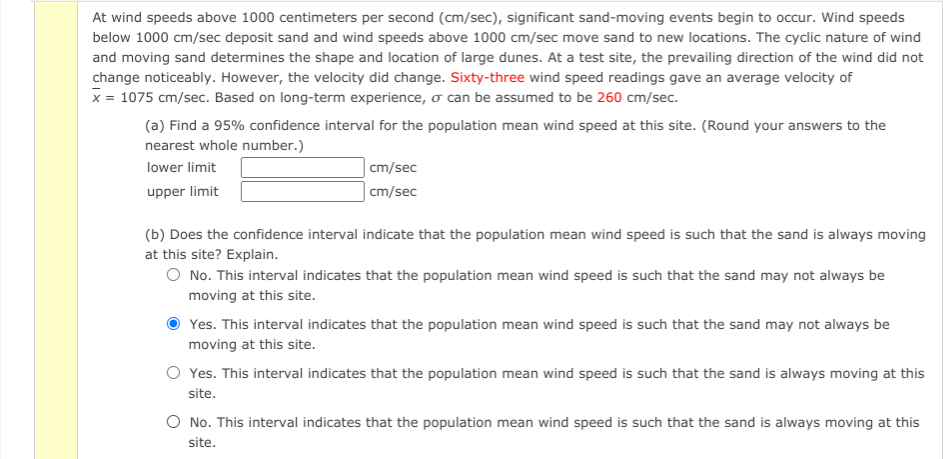At wind speeds above 1000 centimeters per second (cm/sec), significant sand-moving events begin to occur. Wind speeds below 1000 cm/sec deposit sand and wind speeds above 1000 cm/sec move sand to new locations. The cyclic nature of wind and moving sand determines the shape and location of large dunes. At a test site, the prevailing direction of the wind did not change noticeably. However, the velocity did change. Sixty-three wind speed readings gave an average velocity of x = 1075 cm/sec. Based on long-term experience, o can be assumed to be 260 cm/sec. (a) Find a 95% confidence interval for the population mean wind speed at this site. (Round your answers to the nearest whole number.) | cm/sec | cm/sec lower limit upper limit (b) Does the confidence interval indicate that the population mean wind speed is such that the sand is always moving at this site? Explain. O No. This interval indicates that the population mean wind speed is such that the sand may not always be moving at this site. Yes. This interval indicates that the population mean wind speed is such that the sand may not always be moving at this site. Yes. This interval indicates that the population mean wind speed is such that the sand is always moving at this site. O No. This interval indicates that the population mean wind speed is such that the sand is always moving at this site.
At wind speeds above 1000 centimeters per second (cm/sec), significant sand-moving events begin to occur. Wind speeds below 1000 cm/sec deposit sand and wind speeds above 1000 cm/sec move sand to new locations. The cyclic nature of wind and moving sand determines the shape and location of large dunes. At a test site, the prevailing direction of the wind did not change noticeably. However, the velocity did change. Sixty-three wind speed readings gave an average velocity of x = 1075 cm/sec. Based on long-term experience, o can be assumed to be 260 cm/sec. (a) Find a 95% confidence interval for the population mean wind speed at this site. (Round your answers to the nearest whole number.) | cm/sec | cm/sec lower limit upper limit (b) Does the confidence interval indicate that the population mean wind speed is such that the sand is always moving at this site? Explain. O No. This interval indicates that the population mean wind speed is such that the sand may not always be moving at this site. Yes. This interval indicates that the population mean wind speed is such that the sand may not always be moving at this site. Yes. This interval indicates that the population mean wind speed is such that the sand is always moving at this site. O No. This interval indicates that the population mean wind speed is such that the sand is always moving at this site.
Mathematics For Machine Technology
8th Edition
ISBN:9781337798310
Author:Peterson, John.
Publisher:Peterson, John.
Chapter16: Table Of Decimal Equivalents And Combined Operations Of Decimal Fractions
Section: Chapter Questions
Problem 34A: A stamped sheet steel plate is shown in Figure 164. Compute dimensions AF to 3 decimal places. All...
Related questions
Topic Video
Question

Transcribed Image Text:At wind speeds above 1000 centimeters per second (cm/sec), significant sand-moving events begin to occur. Wind speeds
below 1000 cm/sec deposit sand and wind speeds above 1000 cm/sec move sand to new locations. The cyclic nature of wind
and moving sand determines the shape and location of large dunes. At a test site, the prevailing direction of the wind did not
change noticeably. However, the velocity did change. Sixty-three wind speed readings gave an average velocity of
x = 1075 cm/sec. Based on long-term experience, o can be assumed to be 260 cm/sec.
(a) Find a 95% confidence interval for the population mean wind speed at this site. (Round your answers to the
nearest whole number.)
lower limit
cm/sec
upper limit
cm/sec
(b) Does the confidence interval indicate that the population mean wind speed is such that the sand is always moving
at this site? Explain.
O No. This interval indicates that the population mean wind speed is such that the sand may not always be
moving at this site.
Yes. This interval indicates that the population mean wind speed is such that the sand may not always be
moving at this site.
O Yes. This interval indicates that the population mean wind speed is such that the sand is always moving at this
site.
O No. This interval indicates that the population mean wind speed is such that the sand is always moving at this
site.
Expert Solution
This question has been solved!
Explore an expertly crafted, step-by-step solution for a thorough understanding of key concepts.
This is a popular solution!
Trending now
This is a popular solution!
Step by step
Solved in 2 steps

Knowledge Booster
Learn more about
Need a deep-dive on the concept behind this application? Look no further. Learn more about this topic, statistics and related others by exploring similar questions and additional content below.Recommended textbooks for you

Mathematics For Machine Technology
Advanced Math
ISBN:
9781337798310
Author:
Peterson, John.
Publisher:
Cengage Learning,

Algebra & Trigonometry with Analytic Geometry
Algebra
ISBN:
9781133382119
Author:
Swokowski
Publisher:
Cengage

Elementary Geometry for College Students
Geometry
ISBN:
9781285195698
Author:
Daniel C. Alexander, Geralyn M. Koeberlein
Publisher:
Cengage Learning

Mathematics For Machine Technology
Advanced Math
ISBN:
9781337798310
Author:
Peterson, John.
Publisher:
Cengage Learning,

Algebra & Trigonometry with Analytic Geometry
Algebra
ISBN:
9781133382119
Author:
Swokowski
Publisher:
Cengage

Elementary Geometry for College Students
Geometry
ISBN:
9781285195698
Author:
Daniel C. Alexander, Geralyn M. Koeberlein
Publisher:
Cengage Learning

Elementary Geometry For College Students, 7e
Geometry
ISBN:
9781337614085
Author:
Alexander, Daniel C.; Koeberlein, Geralyn M.
Publisher:
Cengage,

Linear Algebra: A Modern Introduction
Algebra
ISBN:
9781285463247
Author:
David Poole
Publisher:
Cengage Learning

Trigonometry (MindTap Course List)
Trigonometry
ISBN:
9781337278461
Author:
Ron Larson
Publisher:
Cengage Learning